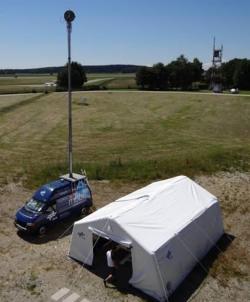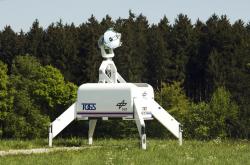
The mobile situation center of VABENE++ consists of a vehicle with an antenna for receiving data transmissions from an airplane, and a portable operations tent. Depending on the given situation, the receiver antenna can also have a stationary mounting, such as on a roof. Inside the tent there is equipment for controlling and monitoring the receiver antenna and processing the incoming data. These data are then distributed and analysed, and the generated products are forward to the relevant portals. The results are finally visualized in the operations tent and can also be provided to users in the form of maps. Because various results can be combined and displayed at one location, it is possible to have a more rapid and detailed overview of a situation than is otherwise possible. The mobile situation center has another advantage: it can be set up quickly and is ready for use in less than an hour.
Data Transmission
There are two different possibilities to transmit the processed aerial images and traffic data from the airplane to the ground station, but at present the microwave link is the one chiefly being used on a routine basis for the mobile situation center. Transmission via an optical data link is being experimentally tested.
Mikrowave Link
Microwave data transmission is being accomplished with the commercial “WINS” system produced by Schulze Radio Systems. The challenge in using this directional radio system comes from the necessity to have the antennas on the aircraft and on the ground constantly in line with each other despite the aircraft movement. In the system being employed this is achieved by determining the precise position of both antennas with the help of GPS receivers and exchanging the momentary position data of each via the data link. The flight direction, orientation and altitude data are also recorded on the aircraft and taken into account when adjusting the aircraft antennas. The system permits a transmission rate of 11 Mbit/s over a maximum range of 70 km.
Optical Data Link
An optical data transmission system was developed to rapidly transmit especially large volumes of data from the aircraft sensors. The optical communication system consists of an optical terminal on the airplane and a mobile ground station. Besides its high data rate the system has the advantages that it can operate without a radio transmission licence and that it guarantees a high level of eavesdropping security.
Transportable Optical Ground Station (TOGS)

The Transportable Optical Ground Station is a versatile and modularized Instrument suitable for numerous experimental optical uplink and downlink scenarios and for measuring in the atmosphere’s optical range. For large public events and disaster situations the mobile ground station can thus record and forward local aerial images and traffic data in real-time.
